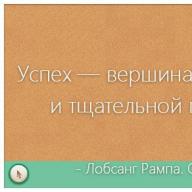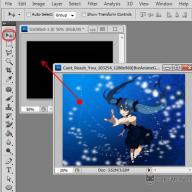To which the newcomers are often lost when the size of the brush is not visible in a non-understanding reason in Photoshop.
Probably you want to know how to make money stably on the Internet from 500 rubles a day? Download my free book \u003d \u003e\u003e
I will tell you a secret, I also got confused when this happened for the first time.
However, as it turned out, there is nothing terrible in this case and the error is corrected quite simple.
So, about everything in order.
In photoshop not visible the size of the brush how to fix
Once, when I, being a novice user of a computer, and a newcomer in the infobusiness, did my first cover for the book I lost my brush.
More precisely, instead of the brush, I only saw a cross, according to which it is difficult to determine the true size of the brush.
Although, before that, everything was fine with the brush. I began to reason why the habitual circuit circle could have lost.
After I used the brush in its normal form, I switched to the text tool.
Posted the headline on the cover in Caps Lock mode, that is, capital letters.
After that, I again chose a brush tool, but it was in the form of a cross.
Looking at the keyboard, I noticed that I did not switch the layout into the previous state, that is, did not turn off Caps Lock.
After clicking on this button, my tassel has become the same - a circle appeared, showing the size of the brush!
This in a simple way, I returned the initial look to my instrument.
However, there are situations where the size of the brush is not visible in Photoshop for other reasons, and we will consider them below.
Installations
If you are disabled Caps Lock, and instead the circle is still a cross, then go to the settings of the program, it is possible that the problem is in them.
Click the Edit tab and descend to the bottom to the word - settings.
By summing up the cursor to it, you will open another menu in which we need to choose - cursors.

After clicking on the string, settings of this tool will open. That is, here you can specify how the cursor of the active instrument will look like in the photoshop program.
Selecting - accurate cursor, you get a cross. For which, however, it is difficult to judge the size of the brush.

And choosing - a normal brush tip, you will receive a circle indicating the size of the selected tool.

By the way, you can choose and a full-sized brush tip, which indicates the size more accurately. That is, a soft bruster is shown not only the area of \u200b\u200bthe painting, but also the blur area.
Scale
If all of the above methods did not fit in your case, then it is possible that your tool is too large.
For example, an open image is sixteen pixels. And the size of the active brush is five thousand pixels.
In fact, you will not see the boundaries of the selected tool in no way, as they are much more pictures.
You will be visible only the central part, that is, the cross in the center of the brush.
You can see the true size of the tassel on the top panel, in the instrument settings.
There you can specify the size you need and adjust the rigidity of the brush.

Immediately you can choose the shape of the brush, from the presented in stock. And if you did not find the desired tassel, it is not difficult to add it.
By the way, on my blog there is a detailed article telling how to do it correctly.
And a few more useful articles:
Outcome
I think that I managed to list all the cases in which the size of the brush is not visible in Photoshop.
However, if you encountered another case, in which the cursor circle disappeared, then share with us in the comments.
Readers will tell you thanks. Yes, and about gratitude, if my article was useful to you and helped solve the problem - do not be lazy to click on the button of social networks.
It is not difficult for you, and I will know that I tried not in vain and helped you return the tassel in a normal state.
On this, I am saying goodbye to you until the next article, I hope - not for a long time. Good luck!
P.S. I apply the screenshot of my earnings in partner programs. And I remind you that everyone can earn it, even a newcomer! The main thing is to do it right, and therefore learn from those who already earn, that is, in the Internet business professionals.Take a list of proven, especially current, 2018 affiliate programs that pay money!
Download check list and valuable bonuses for free \u003d \u003e\u003e "The best partners of 2018"
Situations with the disappearance of contours of the brushes and the icons of other tools are known to many novice masters of photoshop. This causes discomfort, and often panic or irritation. But for the beginner it is quite normal, everything comes with experience, including tranquility if troubleshooting occurs.
In fact, there is nothing terrible in this, Photoshop did not "break", viruses are not hooligany, the system is not junk. Just a little lack of knowledge and skills. This article will devote to the reasons for the occurrence of this problem and its direct decision.
This trouble occurs only for two reasons, both of them are the features of the photoshop program.
Cause 1: Brush size
Check the imprint size of the tool used. It is possible that it is so great that the contour is simply not placed in the work area of \u200b\u200bthe editor. Some brushes downloaded from the Internet may have such dimensions. Perhaps the author of the set created a high-quality tool, and for this you need to set huge sizes for the document.

Cause 2: Capslock key
Photoshop developers in it contains one interesting feature: when the key is activated "Capslock" The contours of any tools are hidden. This is done for more accurate work when using small-sized tools (diameter).
02.09.2016 27.01.2018
Let's get acquainted, in my opinion, with one of the most important and frequently used tools in Photoshop - brush, and find out how it can be configured for more convenient work. Brush can be used not only for direct purpose - in brush tool (Brush.), the range of its use is huge - brushes can be used as such tools as an eraser (Eraser Tool), a darkener (Dodge Tool), a finger (Smudge Tool), Mixer Brush (Sponge Tool) ), Blur (blur Tool.), Sharpness (SharpenTool.) and a few more . Also brush can be used on mask layer and B. selection mode quick mask (Quick Mask). Brush settings We will look at the example tool brushBut you must remember that all settings will work in the event that you choose a brush as any of the above tools.
Well, let's proceed. Create a new document in Photoshop 1000x1000 pixels, file-create (File— New). The size is absolutely not important, you can create a document of any size.
I want to make a small digression and show what I meant when I said that the brush can be chosen as other tools. Activate any of the tools listed above, for example, Mix MixerBrush Tool). Hot Tool Call Key B., To open a drop-down list with subgroup tools, press keyShift. And click on the tool group.
![]()
In the top panel setting mixes brush toolIn the left corner there is a brush selection icon, the location of the icon is identical for all tools.
After clicking on this icon, the drop-down menu will open in which you can choose the desired brush:
![]()
By clicking on this "gear", you can replace your brushes, download new (downloaded from the Internet or standard for photoshop):
![]()
This action will also be relevant to apply to all tools using a brush and, in particular, to tool brush. Return to K. tool brush And its settings. Hot Tool Call Key B., to select a tool from the subgroup, hold down keyShift. And click on the active subgroup of tools or make a long click of the mouse button along the active subgroup.
![]()
For example, I chose the first brush itself from the standard set installed in the default Photoshop soft round. For a lesson, we will replace your brushes to others to consider it to consider how to adjust the vftoshop brush.
![]()
Cluster print form
To call a brush setup menu there are three ways: click on the icon (see screen), go to the menu Window brush (Window-Brush) or press keyF5.
![]()
A window with basic brushes settings in which you can change are:
![]()
1. Brush size (Kehal);
2. The angle and shape of the brush (twist the wheel with the arrow to select these parameters or enter the digital values, also the wheel can be "flattening" - this will change the brush shape);
3. Brush rigidity;
4. Brushes intervals. From the value of the interval depends on what distance the prints of the brush one from the other will be located.
Let's choose a brush with a leaf and see how its imprint will change when the intervals change. Since the brush is already configured earlier, we will take all the checkboxes in the brush settings panel.
![]()
![]()
In the preprint of the print, the print brushes can be seen how the brush will look like the interval value in 25% :
![]()
Run intervals K. 100% :
![]()
After changing the size (keb) of the brush, it will be active here this icon with the arrow, clicking on it you can restore the original brush size.
![]()
Shape Dynamics (Shape Dynamics)
This tab contains tincture to change the shape of the brush.
![]()
Size oscillations (Size Jitter) Changes the size of each print print, in the drop-down control list, you can choose a condition with which the size will change:
Off (OFF) - the size will change in random order
Transition (Fade) - the size will decrease smoothly for the number of steps that are exhibited in the window that appears when this condition is selected:
![]()
The remaining three conditions work only when using a graphic tablet:
Pen Pressure - The size will be changed depending on the pressure on the feather of the tablet.
Pen Tilt (Pen Tilt) - The size will fluctuate depending on the tilt of the tablet pen.
Copier wheel (Stylus Wheel) - Here, to adjust the size of one tablet, it is not enough, you need to have a special handle an airbrush to the tablet.
If you do not have a graphic tablet and you will choose one of these three parameters, a triangle icon will appear with an exclamation mark inside, meaning that this function is not available.
The conditions under which the parameters of the brush will change more than once we meet in other tabs with the brush settings, but we will not focus on them -, firstly, they are identical (with the help of a pen, the size or opacity will change, for example) And secondly, their name immediately makes it clear from what action depends on or another.
![]()
Minimum diameter (Minimum Diameter) -with this parameter, you can adjust the percentage to which the brush will decrease in size.
Angle oscillations (Angle Jitter) -changes the angle of inclination of the print. As in wipes brushes, There are conditions for adjustment.
Form oscillations (Roundness Jitter)- every smear changes its shape as when used deformation tools. For additional settings, use the parameter Minimum form (Minimum Roundness)- It allows you to configure how much the form will be distorted. Also, as in the previous parameters, you can configure changes to the form from some conditions.
ReflectX. oscillations (Flip.X. Jitter)- reflects individual print brushes horizontally, respectively, Reflect Y oscillations "(Flip Y Jitter) - reflects vertical.
Scattering (Scattering)
Scatters chaotic brush strokes in a layer. Used to draw stars, leaves, etc.
![]()
When dispersion 250-350% or more brushes will scatter along the line conducted by the canvas.
Tick \u200b\u200bat the parameter Both axes (Both Axes)allows you to displace prints on both axes, if it is inactive, then the offset occurs only vertically.
Counter (Count) - Allows you to configure the number of prints in scattering. The higher the values \u200b\u200bof the counter, the greater the prints of the brush will be scattered.
Counter oscillations (Count Jitter) - allows you to make scattering uneven.
Texture (texture)
When this parameter is turned on, the texture is added to the brush.
![]()
You can select the texture by clicking on the icon:
![]()
This is how black brush strokes looks like without texture (at the top) and with the addition of the texture "ant farm" from the standard set of patterns (textures):
![]()
![]()
Scale (Scale)- Allows you to change the scale of the texture pattern.
Parameters Brightness and Contrast allow you to adjust the brightness and contrast texture.
Installation Tick at the parameter Texture Each Tip (Texture Each Tip) Opens additional settings:
Mode - Changes texture overlay mode, modes are similar to layer overlay modes.
Depth (depth)- Adjusts the clarity of the texture manifestation.
Wipening depth (Depth Jitter)- Allows you to change the intensity of the previous parameter.
Double Brush (Dual Brush)
Allows you to get an imprint of two brushes at the same time, while the second brush is deducted from the first. The second brush can be selected from the brushes library in the settings window.
![]()
In the settings, you can select the subtraction mode (modes are similar to layer overlay modes), as well as adjust the already familiar settings for us - size, intervals, dispersion and counter.
These are the figures of the indefinite form, it turned out if you add a clear brush to the brush with leaves and play with the settings:
![]()
Color Dynamics (Color Dynamics)
Allows randomly to change the color and transparency of each print brush.
![]()
In order for the function to work, you must pre-set the colors of the front and rear plan in toolbars.
Turn off some settings, some will change to better consider how this parameter works. The color of the foreground I changed on red, background color - on yellow.
![]()
![]()
![]()
![]()
Let's hold the mouth of the canvas from left to right and that's what you get:
![]()
With an active parameter Apply For the tip. Color changes will be applied on each print at the insensitive line, as we have done above. If the parameter is disabled, to change the color you will have to make a click on the mouse for each element, in our case, a leaflet that much complicates the work and takes more time, but you will be able to control the arrangement of the brush.
The fluctuation of the front and rear layout, tone, saturation, brightness and purity You can adjust to your taste. There are no clear rules, everything is breaching by samples, in the preview brush window you can see how it will draw.
Transfer (TRANSFER)
In earlier versions of the Photoshop program, the parameter is called Other dynamics (Other Dynamics). With this parameter, the opacity and the amount of paint in the print prints are adjusted.
![]()
Let's add more settings in the tab to the parameters from the previous step. Transfer:
![]()
We will spend the mouse from left to right. That's what happened:
![]()
Prints brushes unevenly changed the opacity and the number of paint.
Position brush ( Brush. position )
The new parameter added to photoshop not so long ago. Allows you to control the inclination and position of the brush, imitating effects similar to drawing using the pen graphics tablet.
![]()
Used for special standard brushes recently added in Photoshop:
![]()
Other brush options that do not have additional settings:
Noise (Noise) - Adds noise to brush strokes.
Wet edges (WET EDGES) - Applies the effect of watercolor pattern by accumulating paint along the smear.
Airbrush (Airbrush)- imitates the drawing by an airbrush due to the sensitivity to pressing. Correspond to parameter Aerograph On the top panel of the tool settings brush.
Smoothing (Smoothing) - gives smelting brush strokes, softness, used when drawing a graphics tablet with a pen.
PROTECT TEXTURE) - Allows you to give the same scale and pattern to all texture brushes.
During the lesson, you probably paid attention to the "locks" of each brush parameter?
![]()
By default, the locks are not closed, it means that you can change the brush settings. If you select another brush, the settings will automatically disappear, and the new brush will have the default settings. To save the brush with the settings that you applied, "Close" the locks (clicking on them) and click on this icon:
![]()
A window will appear in which you can give the name of the new brush and mark whether the size of the brush is preserved:
![]()
Brush will appear in palette of brushes The last one, you can choose and use it at any time without spending time again on setting.
![]()
![]()
The brushes control window opens:
![]()
In it, highlight the desired brush or several brushes that need to be saved (several brushes can be allocated using keysCRTLas in the usual WINDOVS conductor), then click on save button:
![]()
Assign the name of the brush or set and save on your computer.
![]()
Here you learned how to set up a brush in Photoshop. I hope the lesson was useful to you, but still I urge after reading dry letters not to be experimenting and independently move the sliders, change the settings and pursue with a brush - so the material will fix it much faster. Creative success and inspiration!




